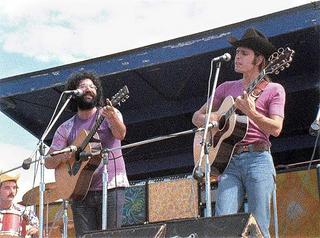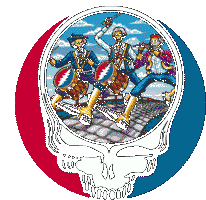Garcia's trip is far from final

From JSonline:
By DAVID BARTON Sacramento Bee
From the time he first stepped on stage with the Grateful Dead, Jerry Garcia, dubbed "Captain Trips" by his following, exhibited the kind of charisma that would make him a revered cultural figure.
Even after his death at 53 from heart failure 10 years ago this month, his influence echoes among the younger musicians and fans of the booming jam-band genre. The same is true for older fans who - long ago won over by the music - sport J. Garcia ties with their business suits and drink J. Garcia wines at suburban dinner parties.
His prolific musical output plays on in archival releases that include the Grateful Dead and his own Jerry Garcia Band. Prints of his paintings sell through art galleries, a line of designer rugs has debuted, and there are neckties and J. Garcia Birkenstocks.
"Shakedown Street," an off-Broadway show based on the songs Garcia wrote with Robert Hunter, opened Saturday in New York. An amphitheater in McLaren Park in San Francisco was renamed for him.
And then there are the fans, like this one who posted feelings on a "10th anniversary" discussion thread on the Web site www.jerry garcia.com : "I find myself wondering how different things might be if he were still around. Would we still have a war?"
But while Garcia's impact as counter-culture guru, jam-band avatar and guitar legend has provoked endless books, Web sites and late-night rap sessions, those who knew him agree on one thing: He couldn't handle the legacy thing.
"As soon as I hear 'impact,' I hear pomposity, and I think, 'Jerry would hate that,' " says Dennis McNally, the Dead's publicist, a longtime Garcia confidant and author of the 2004 book "A Long, Strange Trip: The Inside History of the Grateful Dead" (Broadway Books).
"He never, ever felt worthy of the adoration," says David Gans, another longtime chronicler of the Dead's 40-year saga. "He thought of himself as a regular (guy)."
As McNally recalls, "His standard line was, 'So what the (expletive) do I know?' He knew about his own normal self, the ways he couldn't function."
He was certainly from a humble background, and though he was a considerable visionary in some ways, his first and foremost passions were music and art.
San Francisco born, bred
Garcia was born in the Excelsior section of San Francisco's Mission District, a fifth-generation San Franciscan on his mother's side. He was the son of a musician, Jos, whose parents had come from Spain some years before, and a mother, Ruth, of Swedish and Irish background.
Thus, says McNally, though he is often assumed to be Mexican, from birthplace and surname, "He was ethnically very much a product of his Swedish and Irish grandparents, who raised him while his mother worked."
His dad died when Garcia was 4, drowned while they were fishing on the North Coast. Garcia, guided by his maternal grandfather into music, started playing the guitar in his teens, inspired by the then-new rock 'n' roll (Elvis, Buddy Holly and blues guitarists such as Freddy King were favorites) before discovering the banjo, about which he became obsessive.
According to McNally, Garcia, frustrated by the tiny audience for bluegrass in the Bay Area at the time, toured the South during the summer of 1964, looking for a place to live.
He returned to San Francisco, perhaps because Garcia at heart was a beatnik, absolutely devoted to Jack Kerouac and inclined, say his friends, to speak in the beatnik style.
"He had this really nasal voice," says McNally, mimicking a high, nasal voice. "He chirped. He'd always do a little, 'Hey man, how ya doin'?' "
Eventually, Garcia and fellow music teachers at a local music store formed a jug band. They later were inspired by friend Ron "Pigpen" McKernan (a janitor at the store), who played them the debut Rolling Stones album and suggested a rock band. Thus was born the Warlocks, and a quick name-change later, the Grateful Dead.
Band formed in '65
Formed 40 years ago this month, the Dead became the house band for the LSD-induced "acid test" experiments of the mid-'60s, which grew into the San Francisco psychedelic scene that came to rival "swinging London."
Though initially less popular than other groups in the scene, notably the Jefferson Airplane and Janis Joplin, the Dead far exceeded them in longevity and ultimately became the most consistently successful American touring band of the 1980s and early '90s.
At its peak, the Dead took in as much as $50 million a year in touring grosses.
But, says McNally, "Jerry understood himself to be an heir to Kerouac and was very clear that he didn't want money to have a hold on him. Which meant, in his mind, that he had to spend more than he made. He felt that it was wrong to build it up. He was waiting for his next paycheck the day he died.
"He wanted to love people and make music, and anything resembling conventional materialism was anathema to him. But he was American enough to want a big car."
The Dead was a democracy of diverse players, but Garcia was the acknowledged leader, and his guitar playing - a distinctive, melodic style that was the group's signature sound - was the center of his eclectic artistic universe.
"His reputation is overblown among Deadheads, who can be uncritically admiring," says Gans, who has long hosted radio shows and written books and articles about the band. "They say he's the greatest guitarist who ever lived, but Jerry would be the first guy to say, 'Get a grip.'
"But much of it is merited," adds Gans. "He had a vastly open mind, extremely catholic tastes, and he was a brilliant synthesizer of styles."
He was also a very distinctive player, whose sound developed, but didn't significantly change, over his 30 years with the Dead.
"His sound didn't change that much, whether he was playing a Strat in '71 or a custom guitar in 1990," says Blair Jackson, who has written extensively about the Dead, including publishing a fanzine. "It was just his touch, which is the mark of a great guitarist. . . ."
Health problems
But, as even his admirers note, those hands grew shakier over time. A combination of his increasing use of cocaine and heroin, his worsening diabetes and generally declining health led to heart failure at 53.
This Elvis-like combination has been the subject of much discussion, and McNally in particular objects to the focus on drugs as the cause of Garcia's decline.
"Heroin didn't kill him," he says. "Cheeseburgers, milkshakes and cigarettes killed Jerry Garcia."
Still, drugs were a part of Garcia's life from the time he discovered marijuana at 15, and he was the proud poster child for the psychedelic culture, at least in the early years.
"Jerry was dabbling with everything," says Steve Parish, Garcia's roadie, road manager and the man widely described as his best friend since 1969. "We all were. A lot of the stuff we did with psychedelics we're very proud of. We moved into new frontiers; it took some courage to do that before anyone else."
Gans says Garcia was the leader of an ambitious group of men who were very deliberately trying to expand their consciousness and their community, and they were attempting to do it with music.
"Those guys (the Dead) kicked the door open and stepped through and took a lot of people with them," he says. "And being the conductor of that train, people might have mistaken Jerry for the designer. So it was understandable that he was frightened, annoyed and driven into retreat by it."
Heavy responsibility
The "train" became a juggernaut over time, and Garcia, for one, eventually couldn't handle it. But he had been elected anyway.
"He was the center of a gigantic social system, and he didn't have the will or even power to stop it," says Gans. "People were dependent on him, so many people organized their lives around him. I heard long ago that one of the reasons he stopped talking on stage was he was tired of his words being given more weight than he intended."
"Once you called him 'Captain Trips,' the pressure was on," says Jackson. "I interviewed him after his time as a junkie in the early '80s, and he said he viewed it as 'a long vacation.' And I think it was - a vacation from this huge responsibility."
Being addicted was an inadequate solution, all agree, though it worked for awhile.
"It hurt his art, and it hurt his soul," says McNally. "And it covered up the symptoms of his health problems."
But whether he liked it or not, whether he felt he deserved it or not, there's consensus that Garcia was, at the end of the day, a wonderful leader.
"He was trustworthy," says McNally. "That's why people followed him."
Parish agrees. "He was a great peacemaker. He'd give of himself completely to resolve any conflicts."
Parish watched Garcia's decline on a daily basis, traveling from gig to gig, and says, "There's a simplistic view of (his decline), but the fact is, it was a long process. It was stupid in some ways, but everyone has a dark side."
But, he adds, "The glow the man had shined through his dark side. He wouldn't hurt anyone else, but he hurt himself. It was his way of saying, 'I'm not perfect.' "



0 Comments:
Post a Comment
<< Home